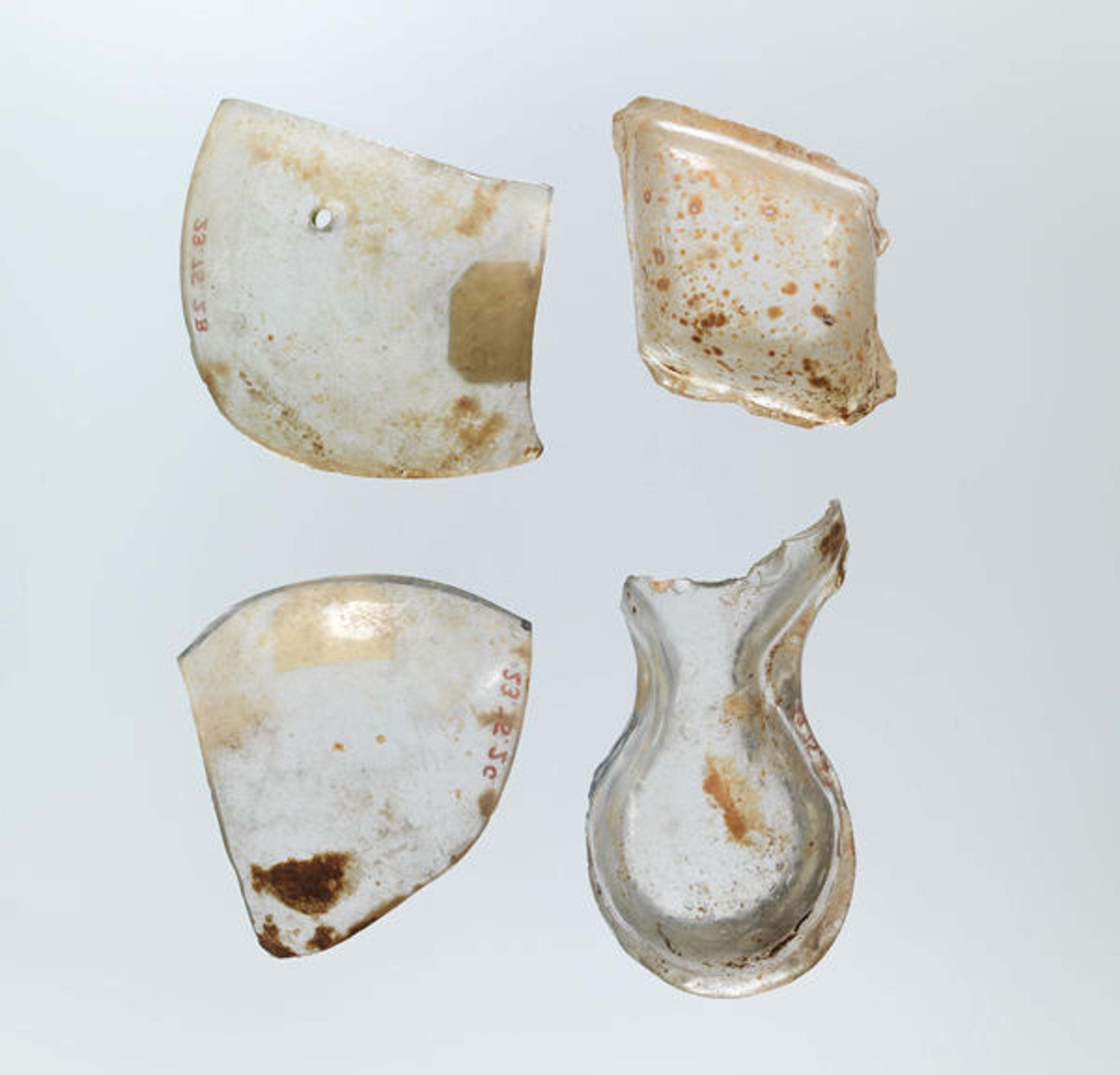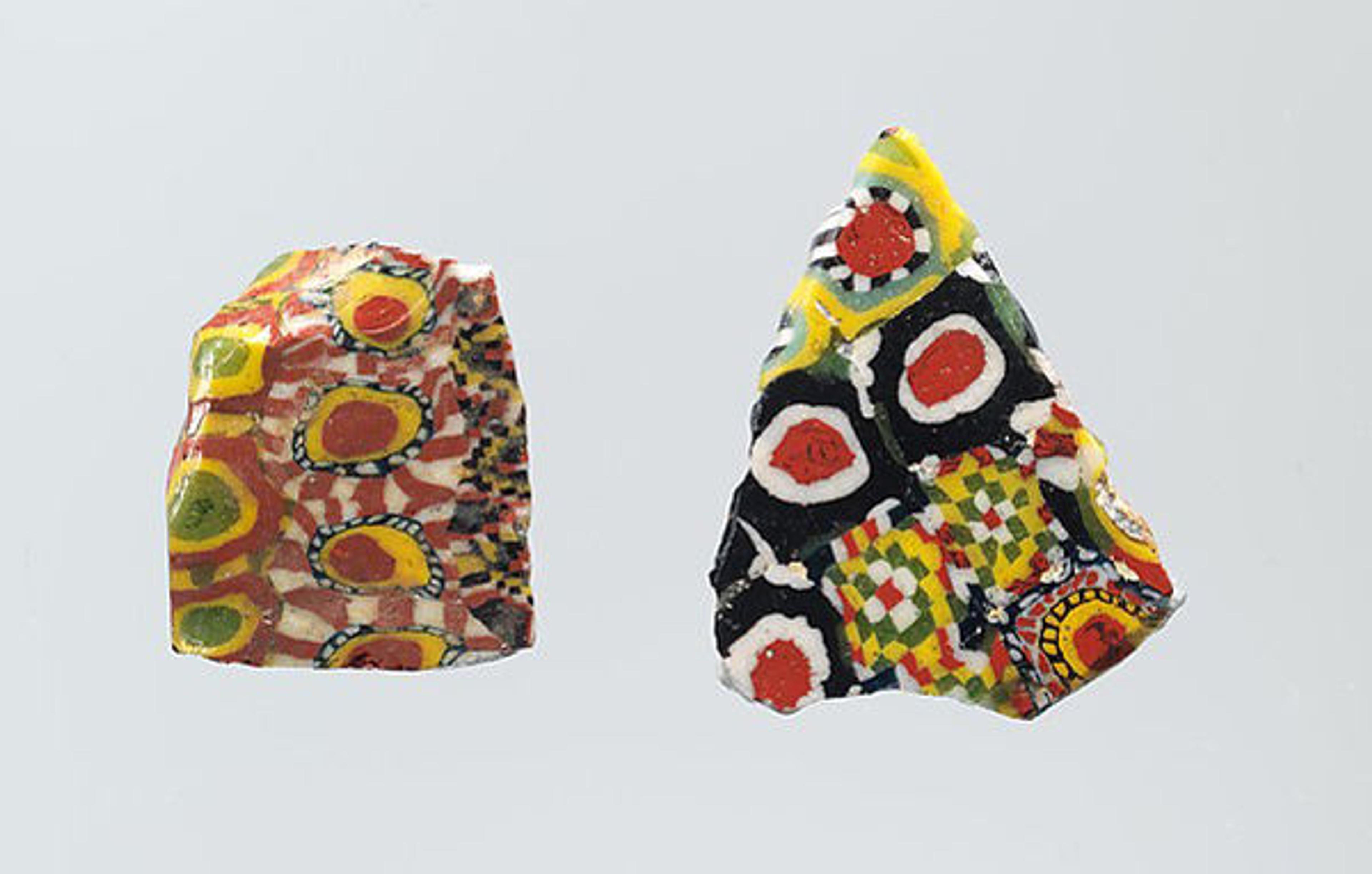
Shaped glass inlay pieces, 9th century. Iraq, Samarra. Islamic. Glass; mold blown and tooled. The Metropolitan Museum of Art, New York, Rogers Fund, 1923 (23.75.2a–d)
«Look at any major early Islamic or late Antique monument, or read any description of those that are no longer standing, and you will likely encounter the medium of glass. Translucent, colorful, and ever so fragile, people in the Near Eastern world prized this substance during ancient and medieval times, where it was used in a variety of ways to add dazzle to the fanciest buildings of the day. On view through January 3, 2016, the exhibition Pattern, Color, Light: Architectural Ornament from the Near East (500–1000) explores the importance of the oft-forgotten glass architectural ornaments of early Islamic buildings.»
Used not only for windows, artists in Islamic cultures also employed glass in intricate wall and ceiling coverings. Because in many cases only fragments remain from the buildings of this period, it is easy to forget about this delicate medium when thinking about architecture. This post introduces a few of the ornaments on display in the exhibition, all of which are from the early Islamic palace city of Samarra, and considers some of the ways medieval viewers thought about glass.
The clear shaped glass inlay pieces from Samarra, shown at the top of this post, are a good example of why it is easy to forget about the glass component of ancient buildings; today they simply appear tiny and unassuming, pieces that one could pass by in a gallery without even noticing. But that isn't the whole story. The pieces were found in the rubble of a series of collapsed rooms in Samarra's main palace, which was built over one thousand years ago, in 836 A.D. The edges of these shaped pieces have traces of stucco clinging to them, which suggested to the excavator that they were once impressed in a bed of plaster, not unlike mosaic tesserae. Reflective pieces of mother-of-pearl cut into similar shapes were also found in the same rubble, further suggesting that these two media were combined to make sparkling wall decorations. Thus, these pieces may have been part of a larger wall covering that glinted in the flickering candlelight of the feasts and evening gatherings held at Samarra.

Mosaic tesserae, 9th century. Iraq, Samarra. Islamic. Glass, green and blue. The Metropolitan Museum of Art, New York, Rogers Fund, 1923 (23.75.1a–l)
The buildings of Samarra also featured decorative mosaics, as is demonstrated by a number of opaque colored glass tesserae found at the site such as the ones shown above. Others came in different colors, and some were also covered in gold leaf. Like the shaped pieces described earlier, we don't have any examples of these mosaics found in situ, so we have to use what evidence we have, as well as our imaginations, to envision their original state.
In this case we have some help in the form of written descriptions from the ninth century. For purposes of posterity, the caliphs who built Samarra's palaces had the practice of hiring poets to describe their works. This was the case with the poet 'Ali ibn Jahm, who is famous for his descriptions of Samarran buildings. Here, he describes the mosaics decorating a dome known as Qubbat al-Mintaqa, or "Dome of the Girdle":
A Dome of Power! As if stars bend close to it, sharing their secrets
Embassies fall to the ground before it when it overwhelms their sense of sight
When it sparkles, their eyes can make the roots of their eyelashes in it
And if its fire is kindled in Iraq, its gleam would illuminate Arabia

Tile fragments, 9th century. Iraq, Samarra. Islamic. Millefiori glass. The Metropolitan Museum of Art, New York, Rogers Fund, 1923 (23.75.15a, b)
Some glass fragments from Samarra still look fabulous despite their fragmentary state. The pieces of glass tile shown above comprise a number of multicolored glass rods that were bundled, cut into a cross section, and fused together. Fragments of these tiles were found in the same area as the clear shaped pieces above. Today they delight us with their abstract forms and vibrant colors. In ninth-century Samarra, entire sections of walls featured such opulent decorative forms.
We do know that some medieval authors thought glass to be a wonder, possibly because it represented the final product of a complete visual transformation. The ninth-century intellectual figure known as al-Jahiz compared glassmaking to alchemy, stating that it was all the more amazing since finished glass resembles its origin, sand, even less than gold resembles the base metals that alchemists attempted to transform. The Arab poets made similar connections. In a poem describing a glass drinking cup, Ibn al-Rumi, also from ninth-century Iraq, praised the vessel for its clarity and luminosity. His words are a fitting way to end this post:
Crafted from a substance, clear by nature
Not clarified through alchemy
The eye penetrates right through it
You see the eye missing the cup due to the thinness of the walls
Like air without dust motes mixed with light
Nay—finer than that and clearer.
Related Links
Pattern, Color, Light: Architectural Ornament in the Near East (500–1000), on view July 20, 2015–January 3, 2016
View all blog posts related to this exhibition.